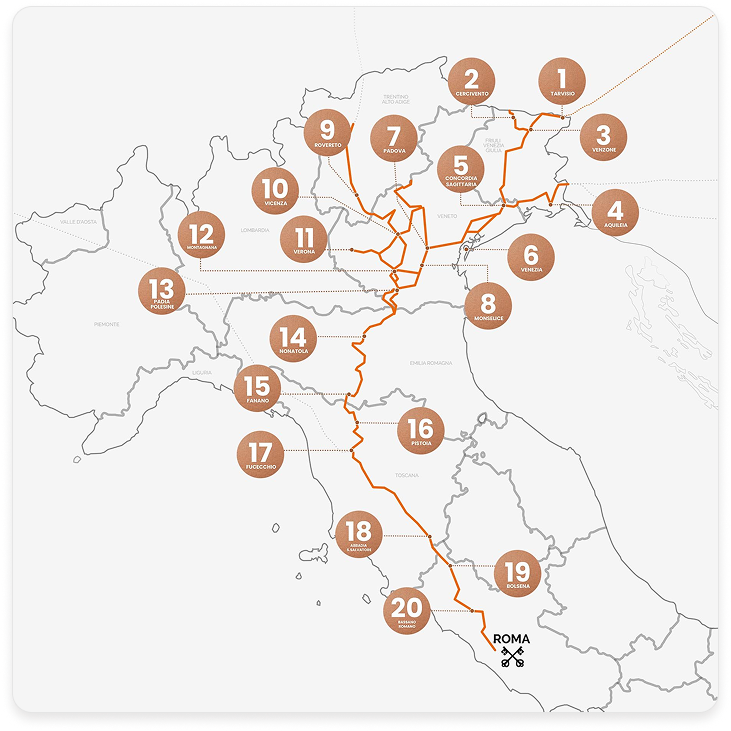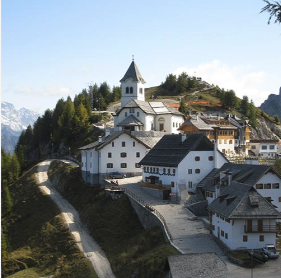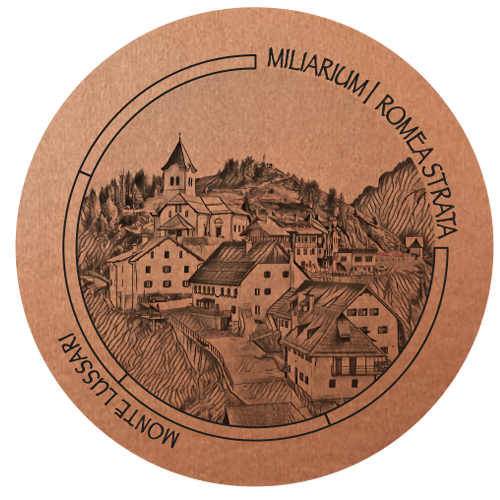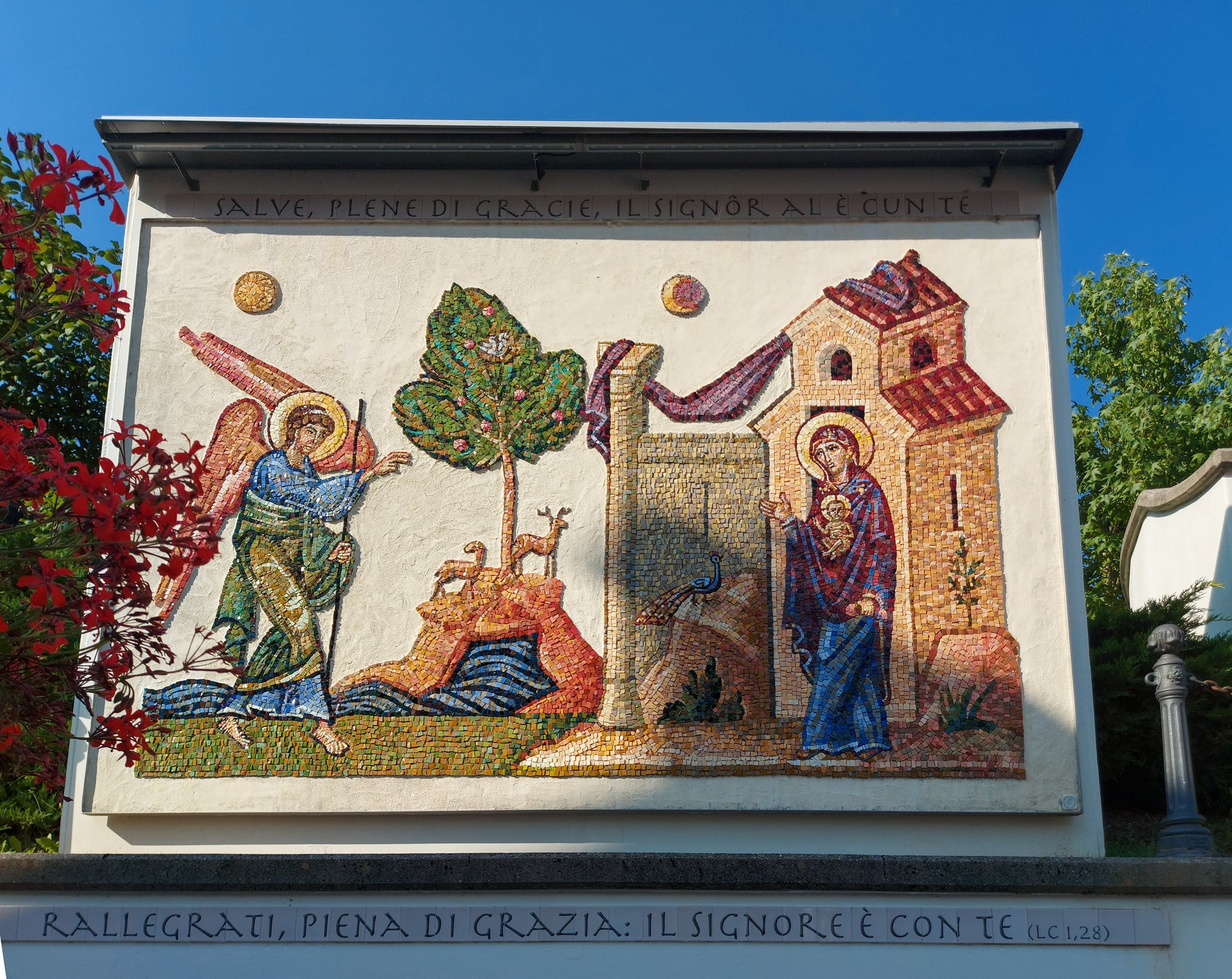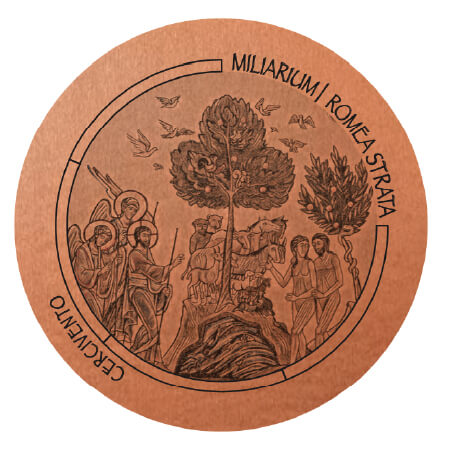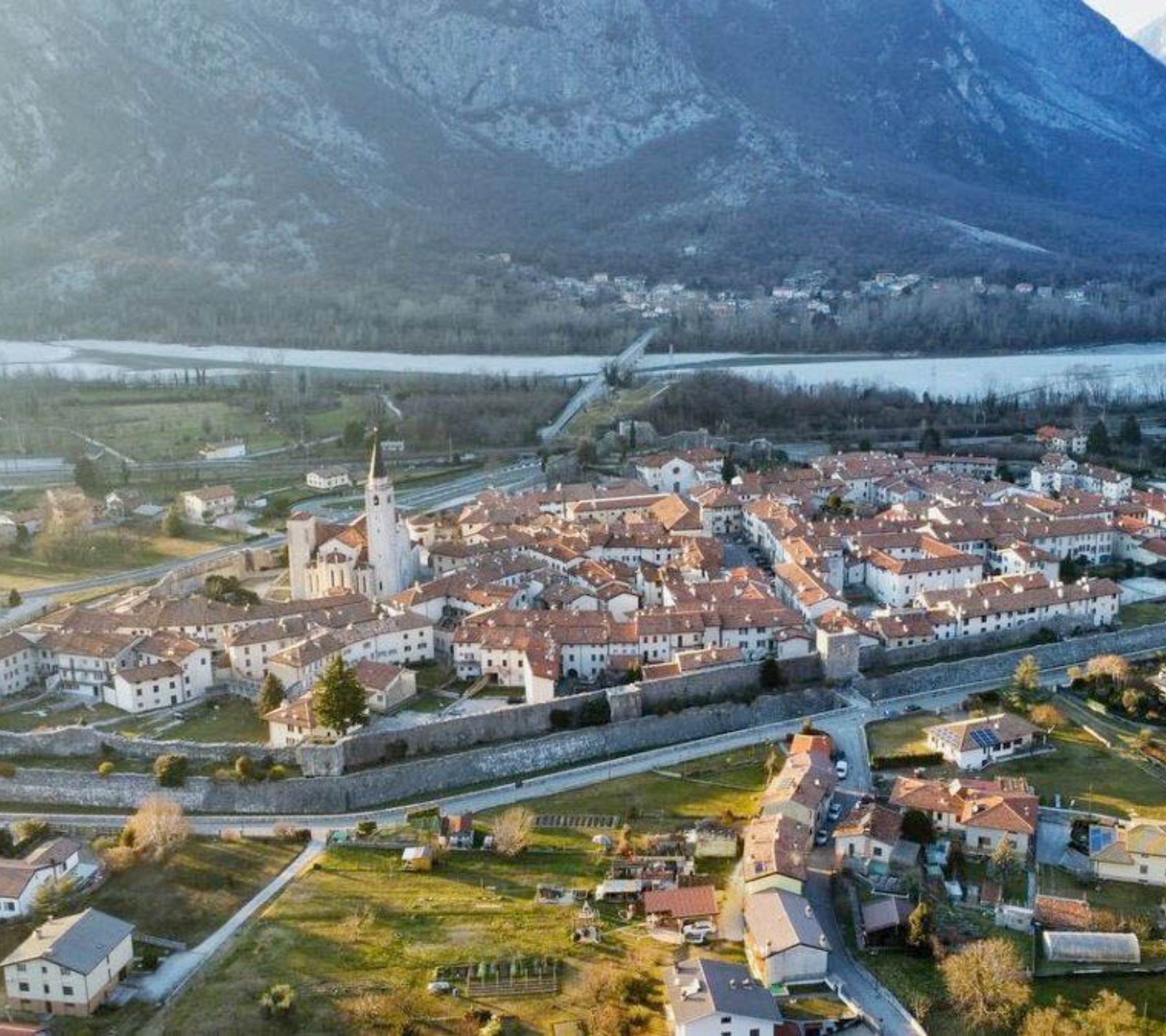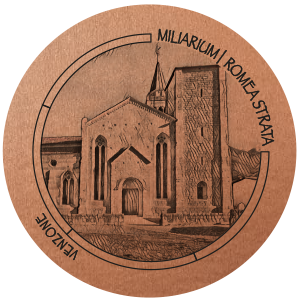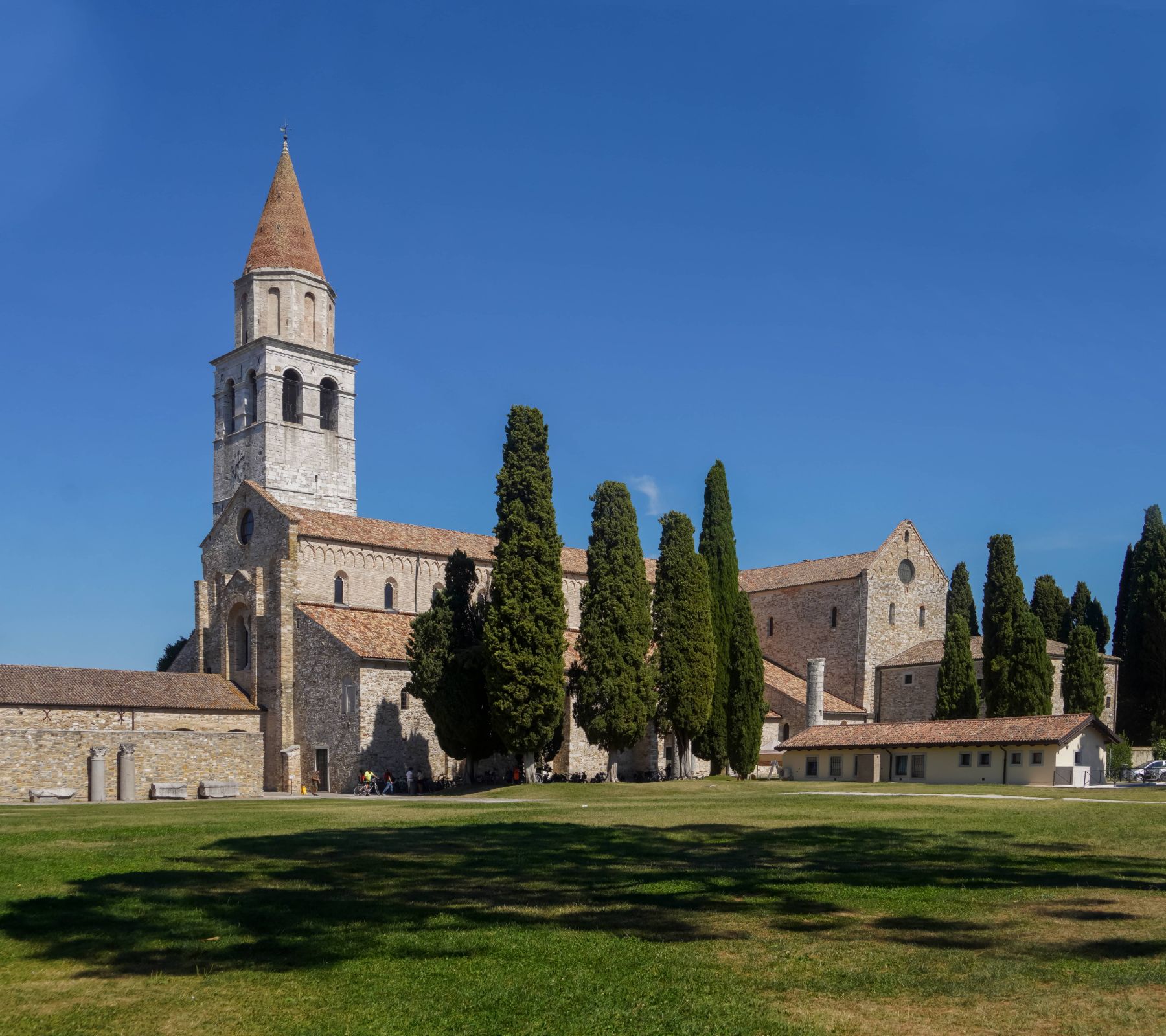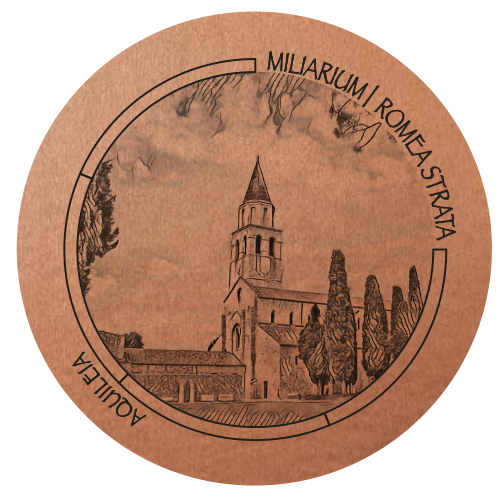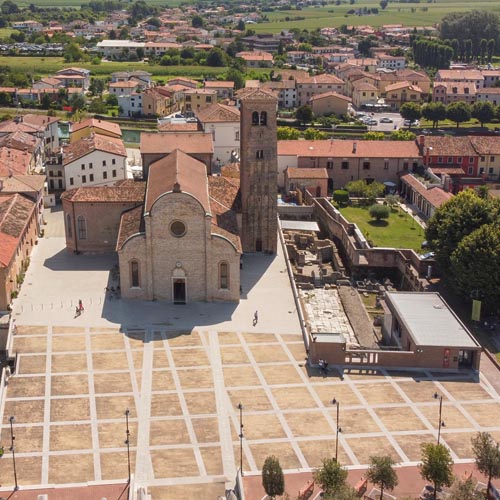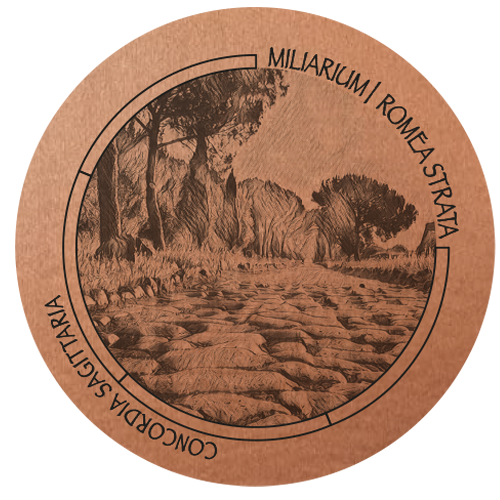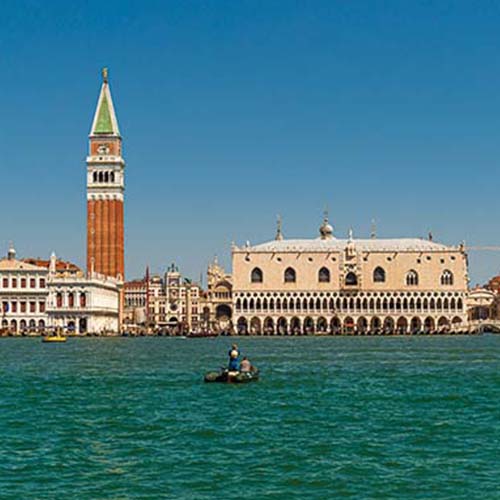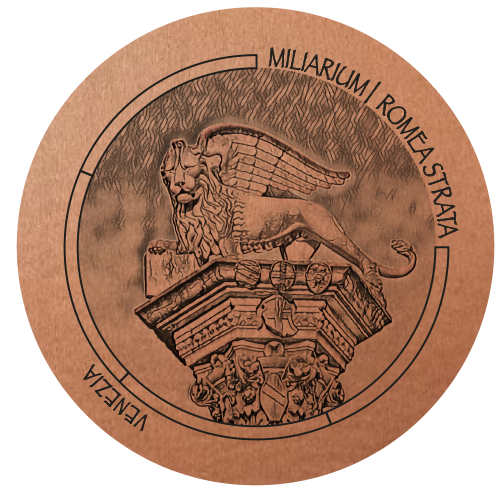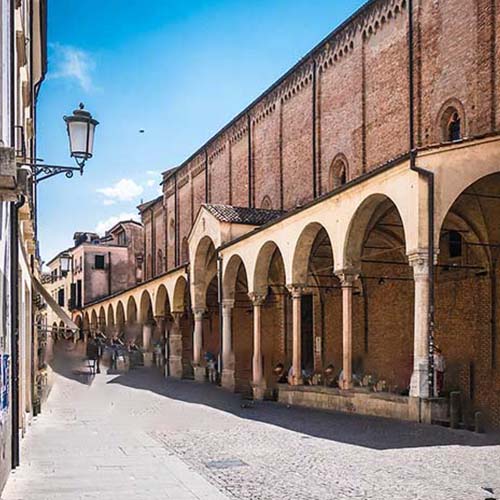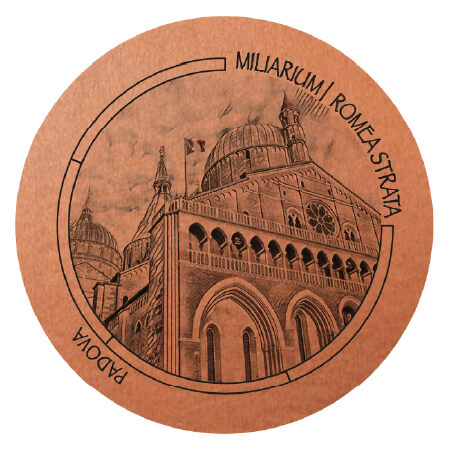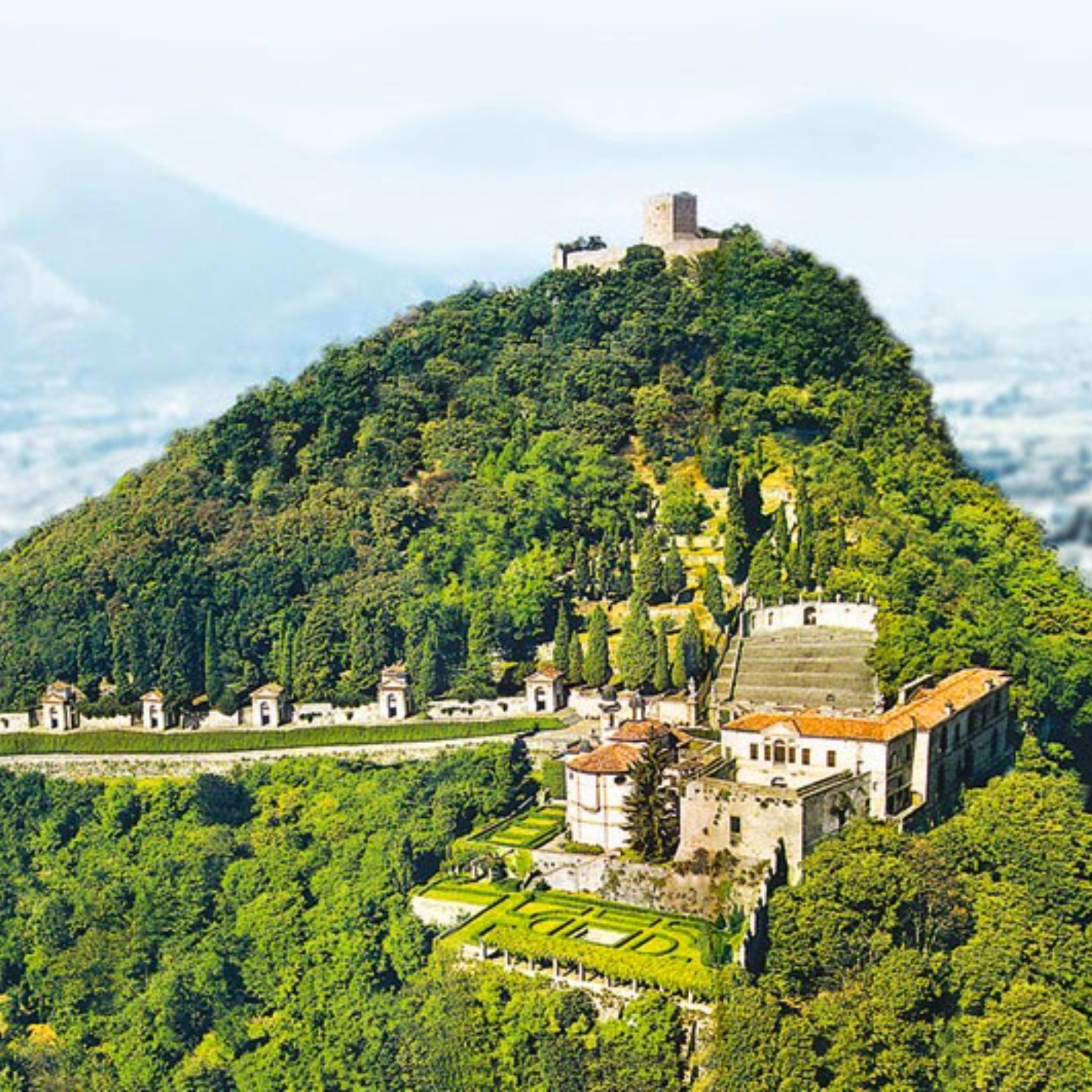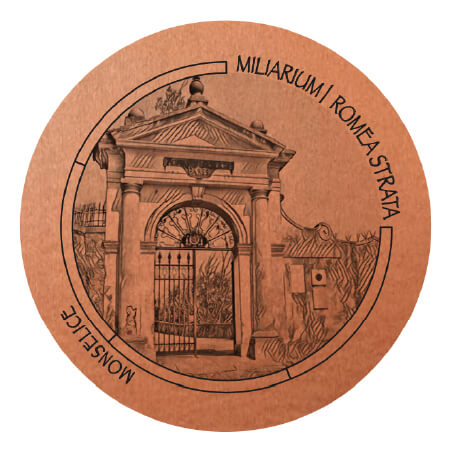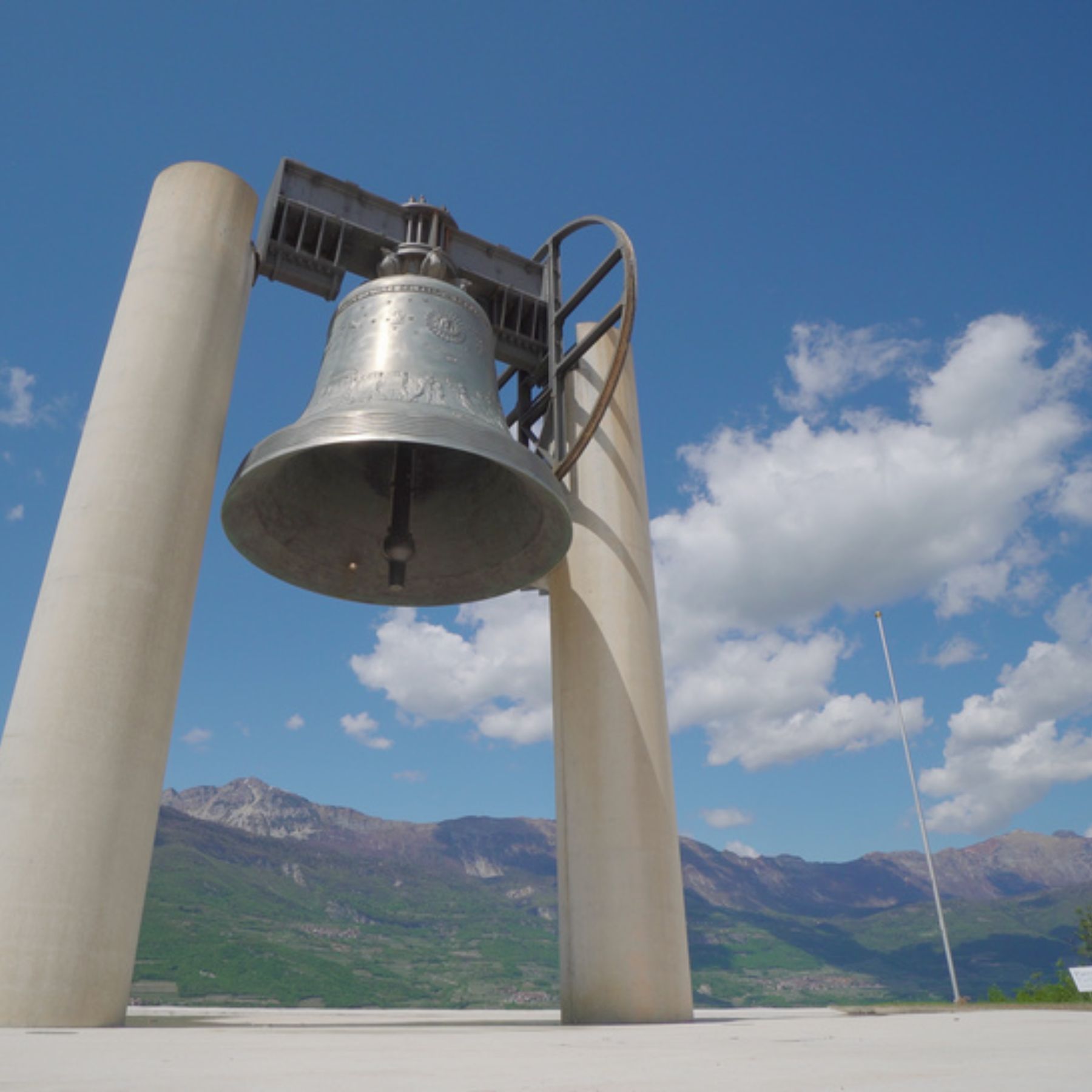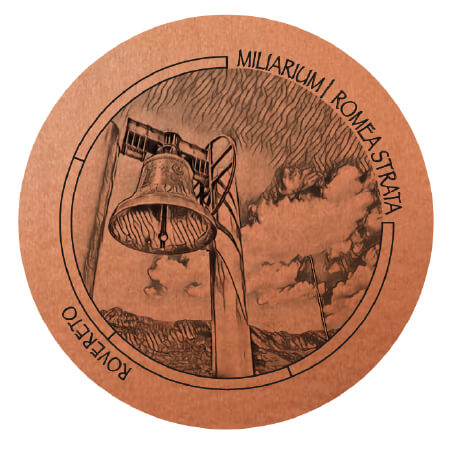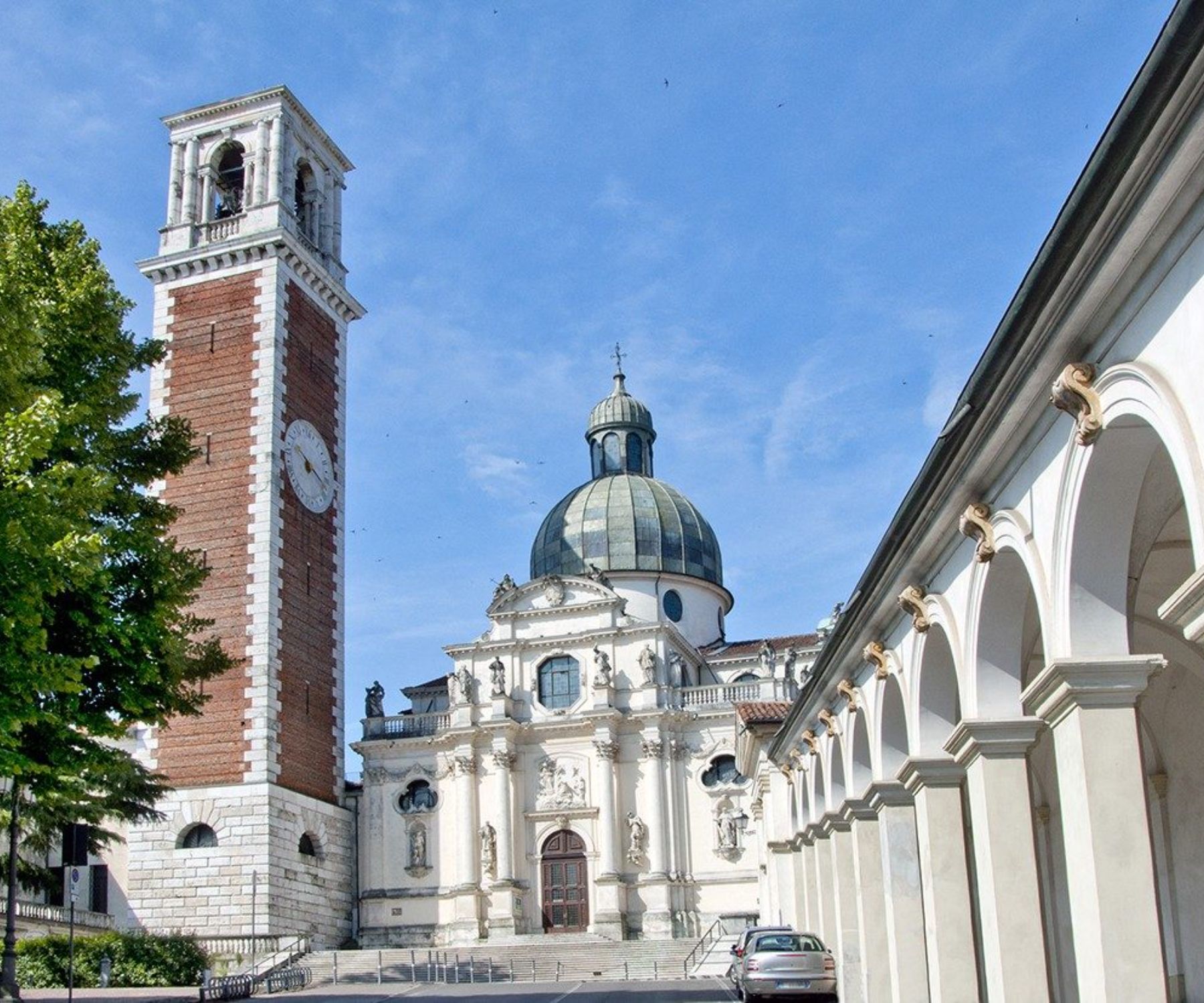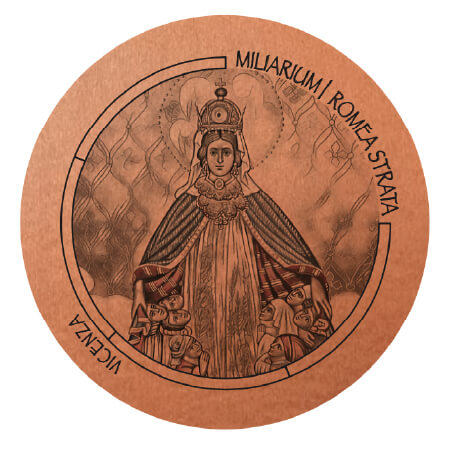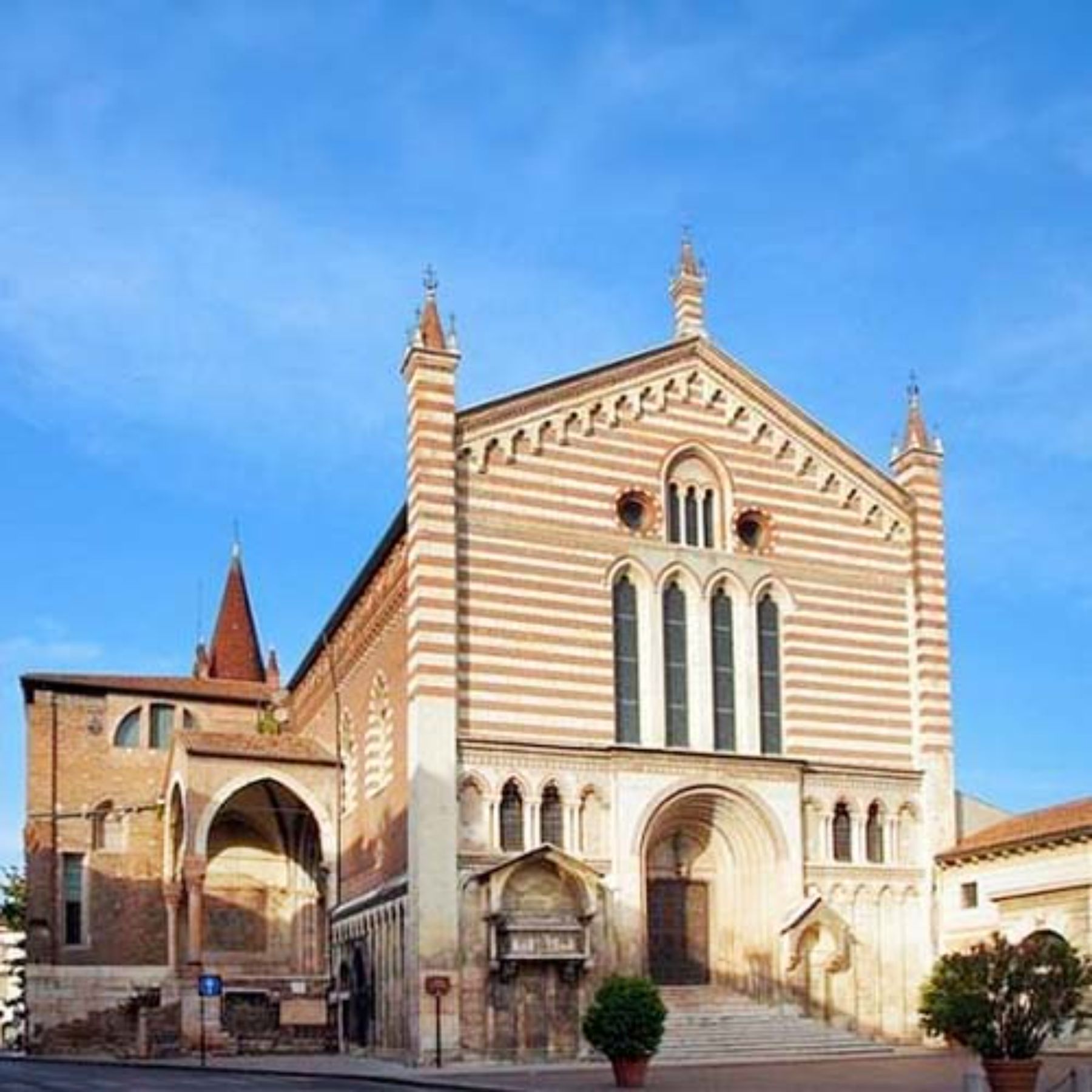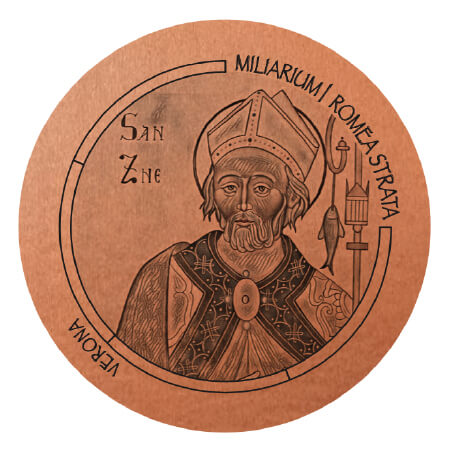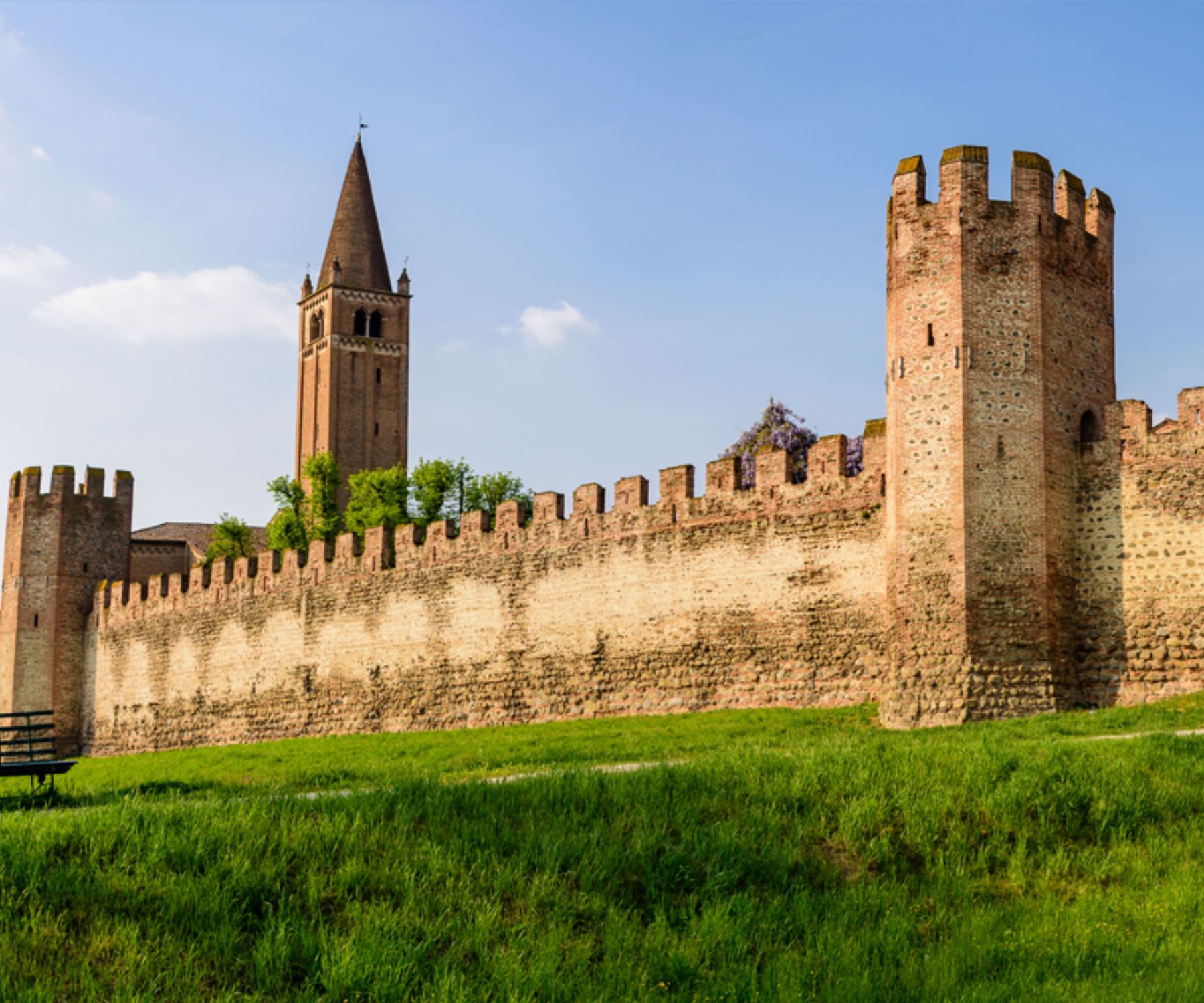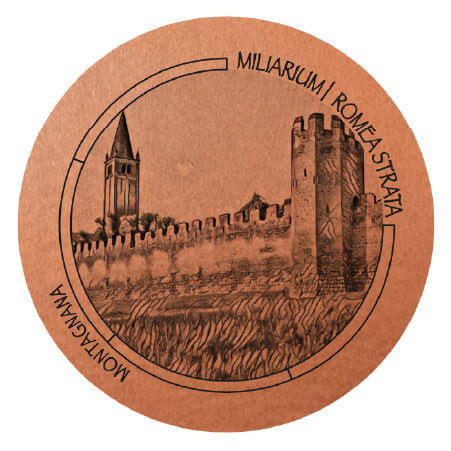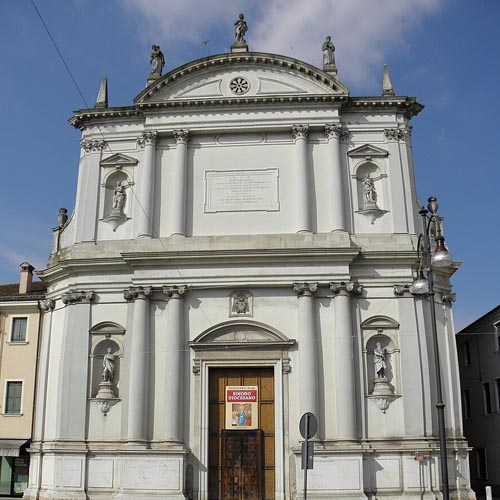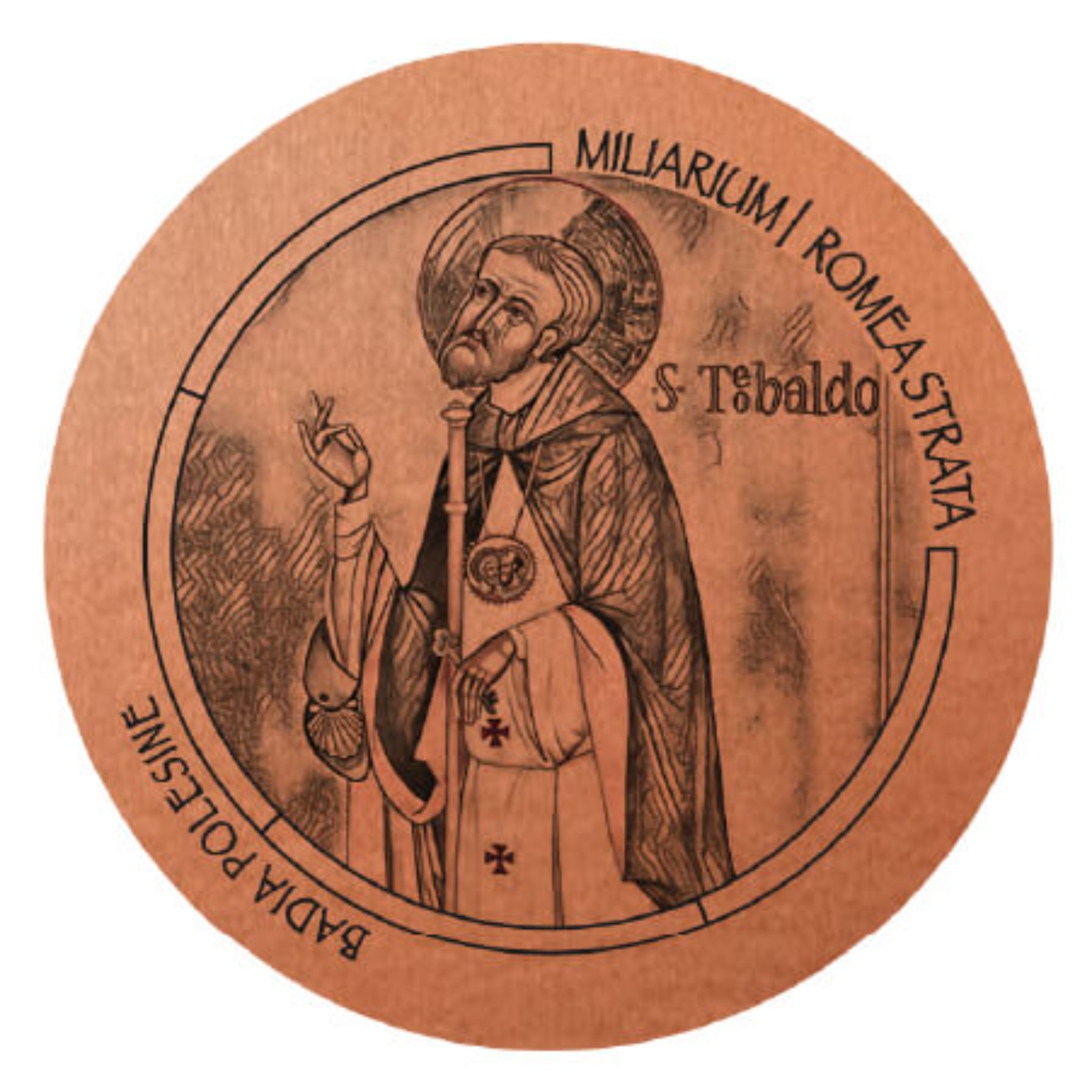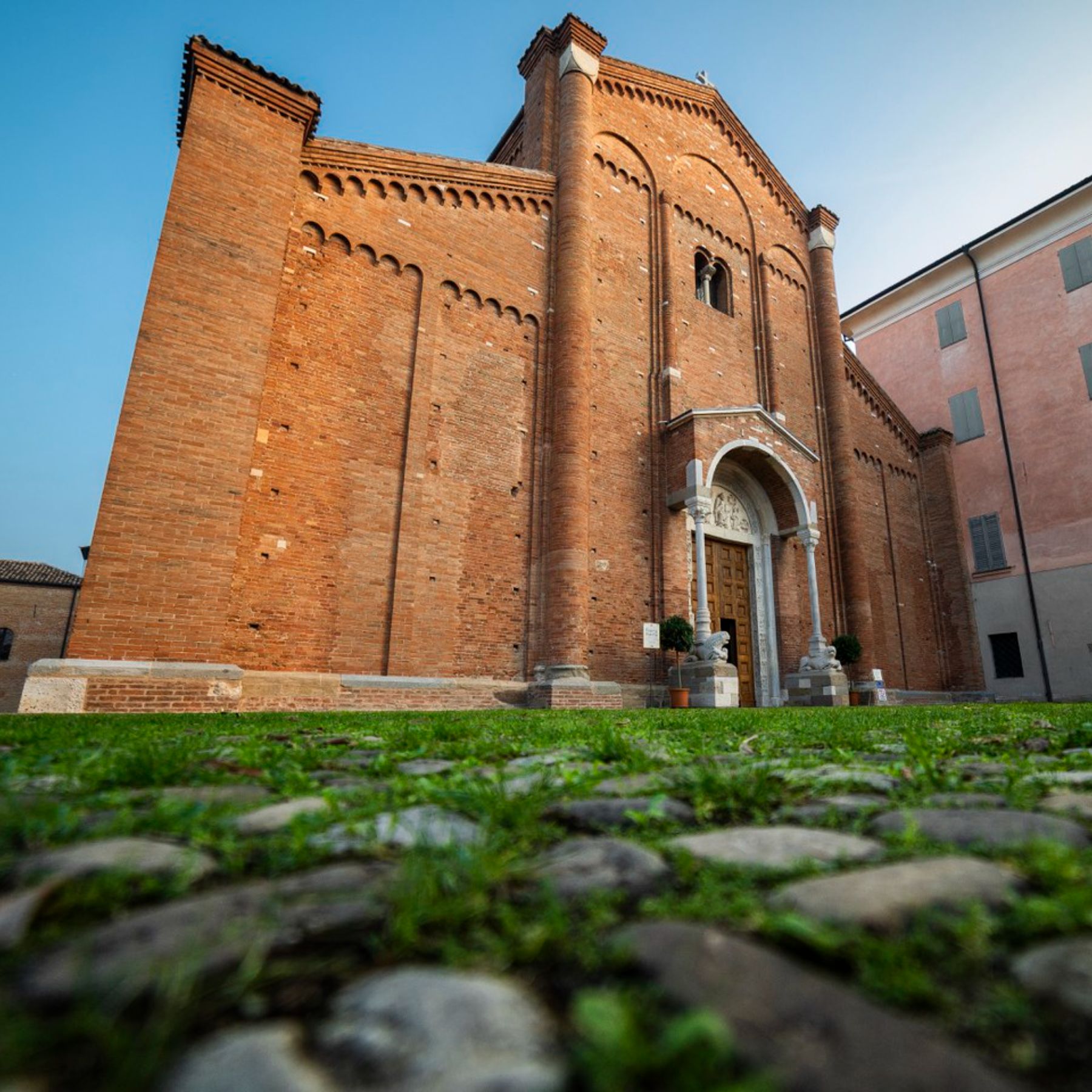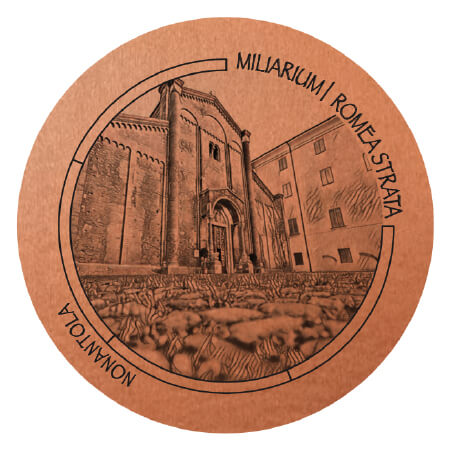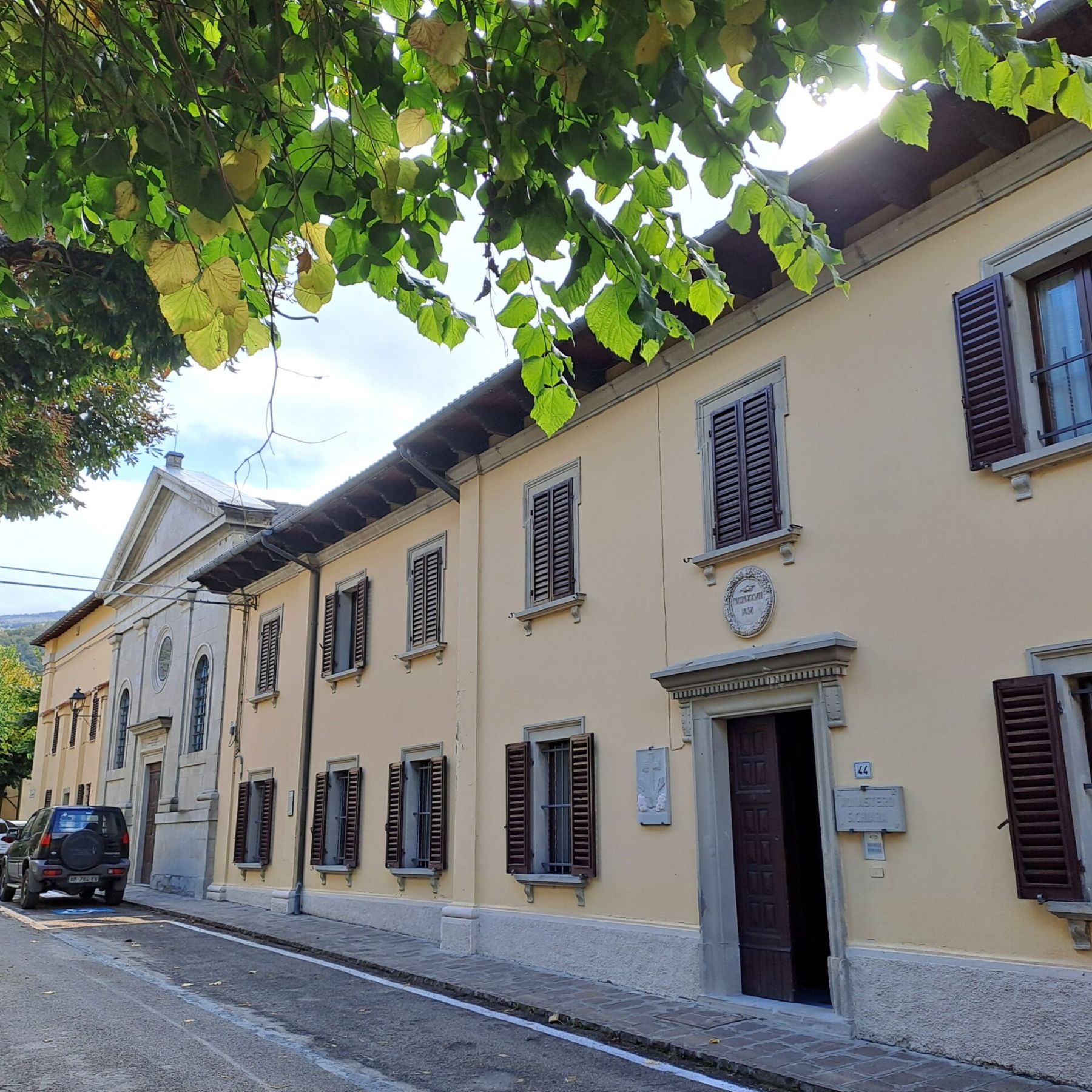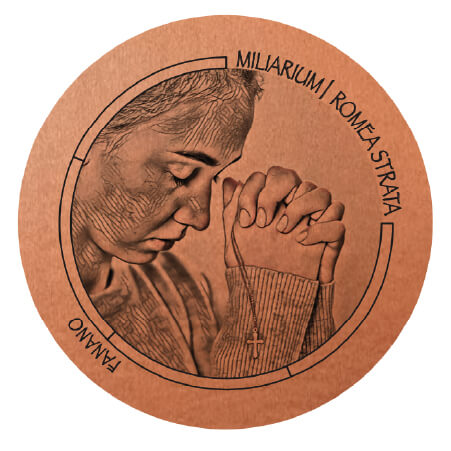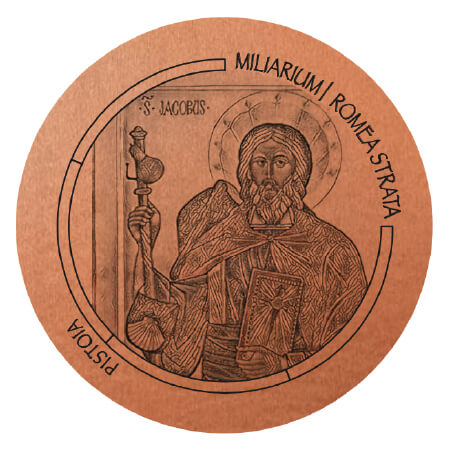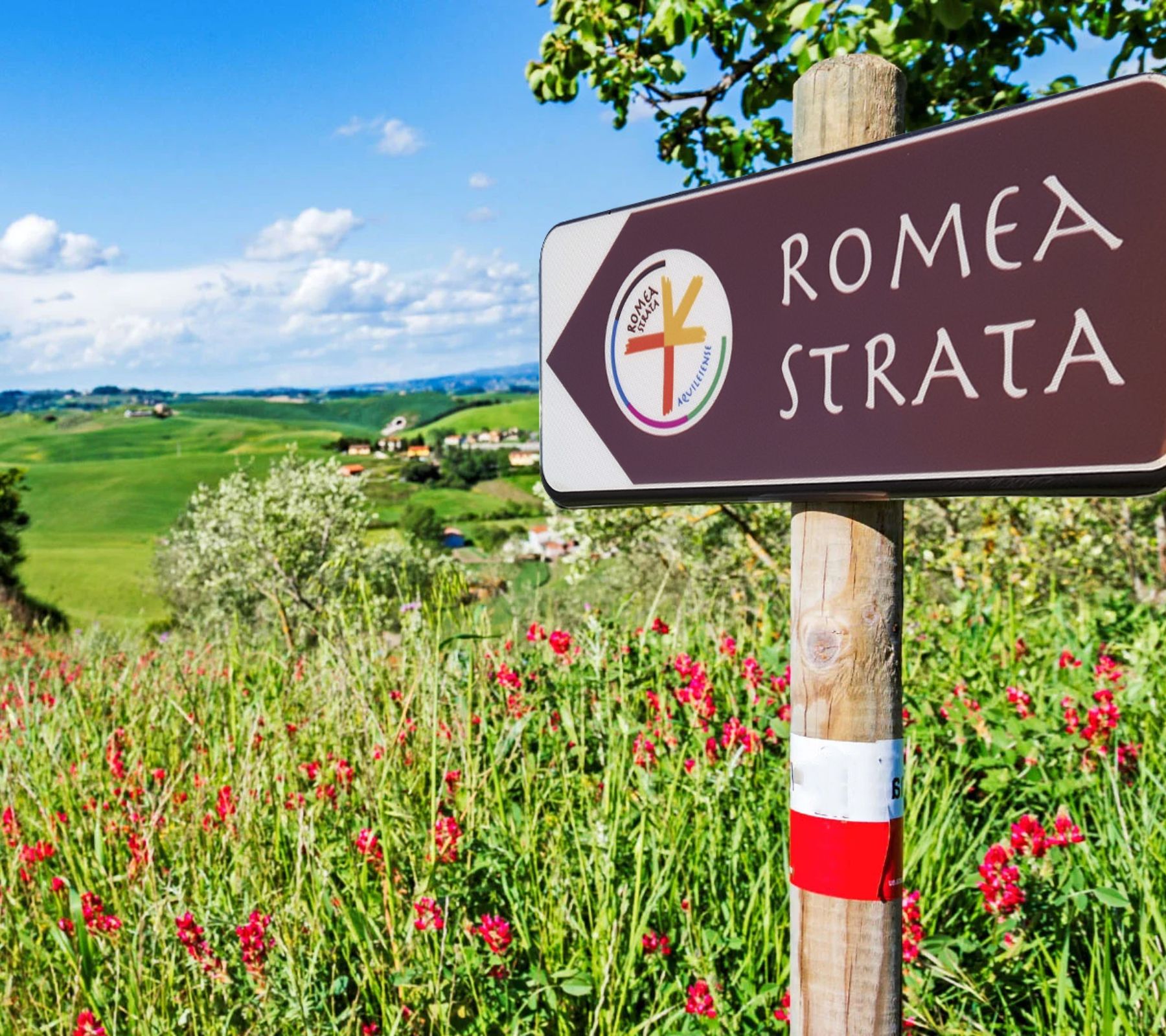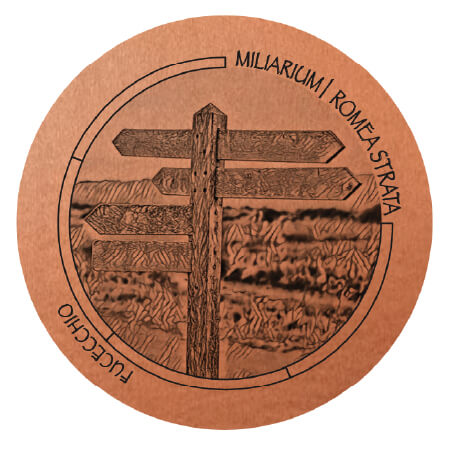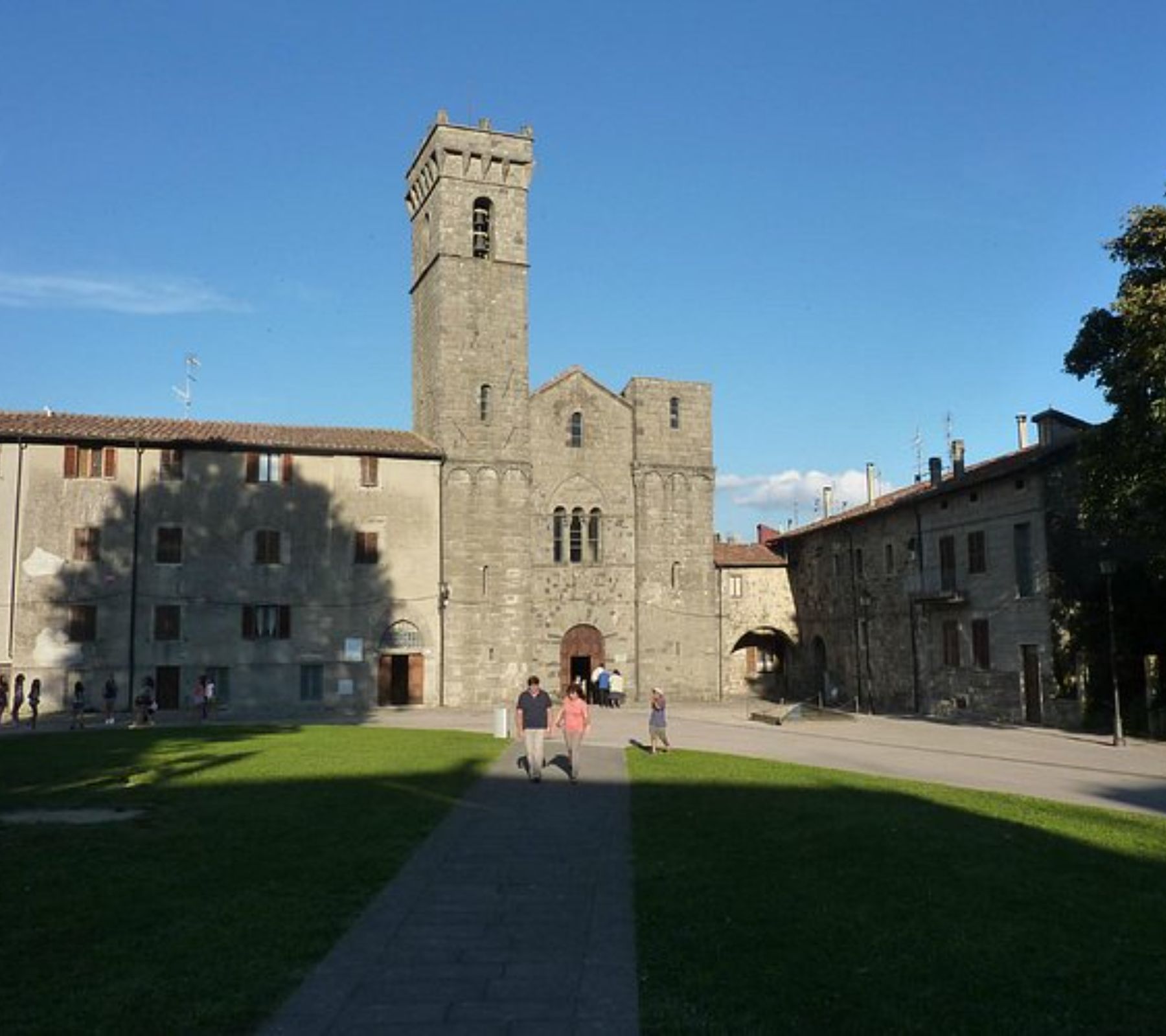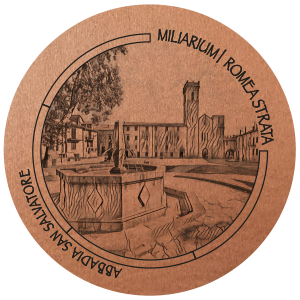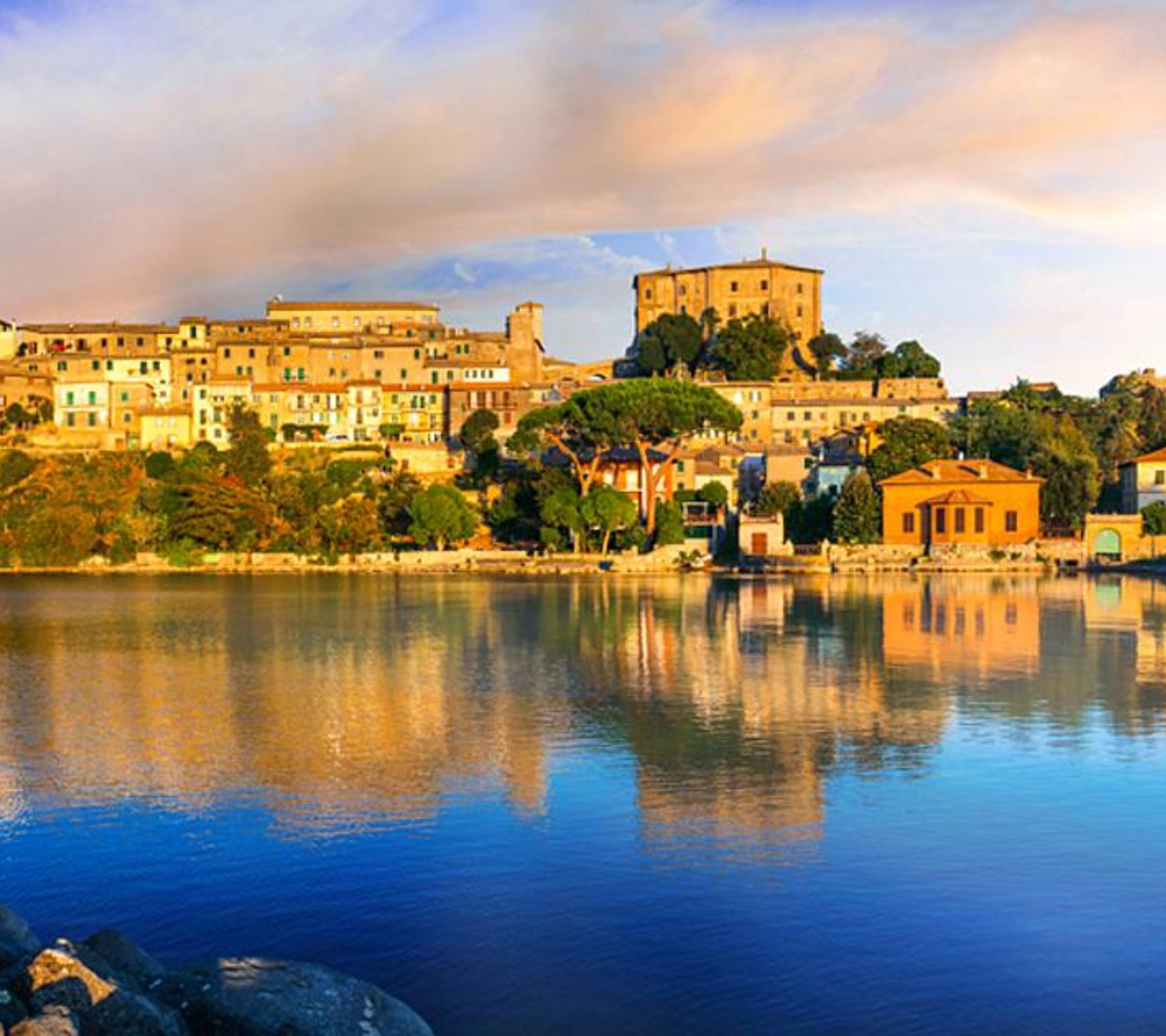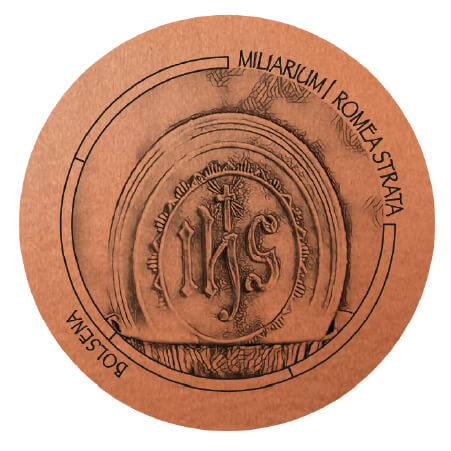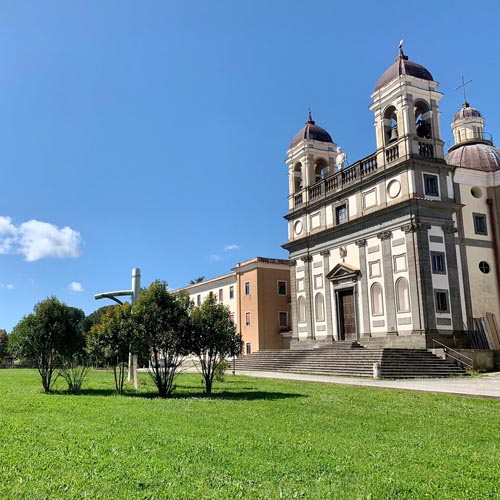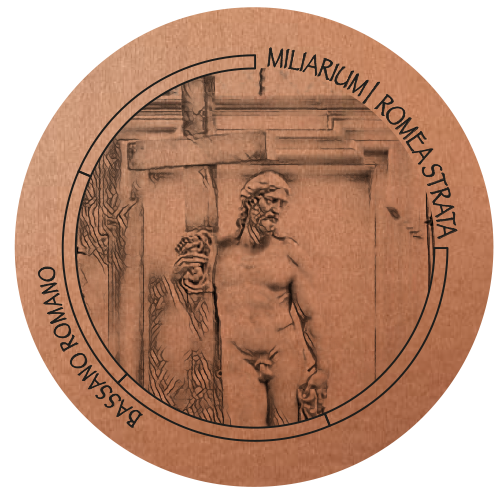Miliarium - Italy
The jubilee sites
Giubileo 2025 | Miliarium - Italy
The Miliarium is a symbolic recognition that celebrates the pilgrim’s passage through one of the Jubilee sites along the Via Romea Strata in Italy. Each Jubilee stage has its own Miliarium, delivered as a sticker to be applied to the pilgrim’s credential: a tangible sign of the journey experienced and the spiritual path undertaken.
To receive it, you must have completed at least two consecutive stages, on foot or by bicycle, following the official tracks. It’s not the distance that counts, but the geographical and temporal continuity of the route. The stamps collected along the way testify to the actual journey and allow you to obtain the corresponding Miliarium.
After collecting three Italian Miliarium, you can request the final Testimonium, the official document certifying the completion of your Jubilee pilgrimage to Rome. The Testimonium is collected at St. Peter’s Basilica, in the heart of the Eternal City.
It is not necessary to travel the last 100 km on foot (or 200 km by bike) of the Via Romea Strata: what matters is the coherence of the journey, the spiritual meaning, and the testimony collected stage after stage.
The stages of the Miliarium - Italy
01 – TARVISIO | SANCTUARY OF MADONNA DEL LUSSARI
In the extreme northeast of Italy, among the easternmost peaks of the Julian Alps, stands Monte Lussari, a symbolic place where three worlds have met for centuries: Latin, Germanic, and Slavic. Its sanctuary, known as the church of the three peoples, has always been a pilgrimage destination for Italian, Friulian, Slovenian, and German-speaking faithful. Today, in peacetime, this place keeps alive an ancient vocation: to be a bridge between cultures, faith, and friendship. Monte Lussari is a true European sanctuary, a crossroads of languages and spirituality, along the Via Romea Strata.
Where to receive the Miliarium: Tarvisio InfoPoint
Via Roma, 14, 33018 Tarvisio (UD)
info.tarvisio@promoturismo.fvg.it
Tel +39 0428 2135
Hours: Every day 8:30 AM – 12:30 PM and 2:00 PM – 6:00 PM
How to receive the Miliarium:
you must complete the last two stages of the Via Romea Strata in Austria.
02 – CERCIVENTO | OPEN-AIR BIBLE
In the heart of the Friulian mountains, Cercivento transforms into a surprising Open-Air Museum: mosaics, murals, and frescoes inspired by Holy Scripture decorate the houses and buildings of the village. The words of the Bible, translated into Italian and Friulian, guide visitors on a unique journey of art, faith, and reflection, accessible to pilgrims, tourists, and anyone who wishes to be touched by spiritual beauty. Cercivento is a journey through the Scriptures, engraved on the walls of an entire town.
Where to receive the Miliarium: IAT Venzone Office
Via Glizoio di Mels 5/4, 33010 Venzone (UD)
Tel. +39 0432 985034
Hours: Tuesday – Sunday: 10:00 AM – 1:00 PM; 3:00 PM – 6:00 PM. Monday closed.
How to receive the Miliarium:
you must travel the Romea Iulia Augusta from Cercivento to Venzone.
03 – VENZONE | DUOMO OF SAINT ANDREW THE APOSTLE
In the heart of the medieval citadel of Venzone, the Duomo of Saint Andrew the Apostle represents a symbol of faith and rebirth. Built starting in 1251 by the will of Glizoio di Mels, it probably stands on an early Christian place of worship dating back to the 6th century, testifying to the spiritual continuity of this territory. Consecrated in 1338 by the Patriarch of Aquileia, Bertrando di Saint Geniès, the Duomo is one of the most significant monuments in the Friulian region. Completely devastated by the 1976 earthquake, it was faithfully reconstructed through an imposing anastylosis operation, combining technology, craftsmanship, and collective memory. Today, the Duomo of Venzone is not only a place of worship but also a tangible sign of the resilience and spiritual strength of a community, along the Via Romea Strata.
Where to receive the Miliarium: Ufficio IAT Venzone
Via Glizoio di Mels 5/4, 33010 Venzone (UD)
Tel. +39 0432 985034
Hours: Tuesday – Sunday: 10:00 AM – 1:00 PM; 3:00 PM – 6:00 PM. Monday closed.
How to receive the Miliarium:
you must travel the Romea Iulia Augusta from Cercivento to Venzone.
04 – AQUILEIA | BASILICA OF AQUILEIA
In the heart of the ancient Roman city, the Basilica of Aquileia is one of the most emblematic places of Christianity in northern Italy. Founded on an early Christian site, it now represents a heritage of faith, art, and historical memory that spans centuries. The interior of the basilica is famous for its extraordinary 4th-century floor mosaics, among the most extensive in the ancient Christian world. Biblical scenes, symbols, and figures tell the story of the birth of the Church and the life of the first Christians, involving the visitor in a journey between spirituality and artistic beauty. Aquileia is not just a center of worship: it is a witness to the Christian roots of Europe, a fundamental stage along the Romea Strata, and invites you to stop and contemplate the historical and religious depth that still inhabits these places.
Where to receive the Miliarium: Basilica Shop
Piazza Capitolo (next to the Basilica)
Tel +39 0431 917698
Hours: you can find them on the website www.basilicadiaquileia.it/shop
How to receive the Miliarium:
you must travel stages RSIT01 + RSIT02 of the Via Romea Aquileiense from Miren, or the 2 stages of the RSIT01 variant from Manzano to Aquileia through Gorizia.
05 – CONCORDIA SAGITTARIA | CHURCH OF SANTO STEFANO
In the heart of Concordia Sagittaria, the Church of Santo Stefano is a place of deep spirituality and ancient memory. Built on one of the most significant Christian sites in the region, it preserves one of the oldest baptisteries in the area, a symbol of the first proclamation of the Gospel and the beginning of the Christian journey. The adjacent archaeological area offers an extraordinary immersion in history: the remains of ancient early Christian basilicas and an original section of a Roman road lead the visitor on a journey that intertwines faith and civilization, stones and prayer. Concordia Sagittaria is a precious stop along the Via Romea Strata, where every corner tells of the spiritual continuity between antiquity and the present, in the sign of a living tradition.
Where to receive the Miliarium: Cathedral of Santo Stefano
Via Roma, 58, 30023 Concordia Sagittaria (VE)
parr.concordia@diocesiconcordiapordenone.it
Tel. +39 0421 270269
Hours: you can find them on the website
How to receive the Miliarium:
you must travel stages RSIT06 + RSIT07 of the Via Romea Allemagna.
06 – VENICE | CHIESA DEGLI SCALZI (CHURCH OF THE DISCALCED CARMELITES)
Venice, a city suspended between water and sky, is a millennial crossroads of cultures, faiths, and peoples. At the center of its spiritual identity stands St. Mark’s Basilica, one of the most emblematic places of European Christianity. Dedicated to the evangelist Mark, its golden domes and Byzantine mosaics tell the stories of the Gospel with extraordinary beauty, transforming art into prayer. But Venice is also a testament to religious plurality: the nearby Jewish Ghetto, among the first in Europe, preserves centuries-old synagogues and a profound spiritual heritage. These places narrate the sometimes difficult encounter between different faiths that have managed to coexist here. In the heart of the Via Romea Strata, Venice presents itself as a place of pilgrimage and dialogue, where every step evokes the deep bond between culture, faith, and shared history.
Where to receive the Miliarium: Chiesa degli Scalzi
Cannaregio, 54, 30121 Venice (VE), next to the Venezia S.L. train station
Tel 041 8224006
Hours: Monday-Sunday 7:00 AM – 12:30 PM and 3:00 PM – 6:30 PM; Ask the sacristan or confessor.
How to receive the Miliarium:
you must travel stages RSIT10 + RSIT11 of the Via Romea Annia. From Mestre, Venice is reached by train.
07 – PADUA | CHURCH OF SANTA MARIA DEI SERVI
In the historic center of Padua, the church of Santa Maria dei Servi stands out for its unusual position, overlooking Via Roma with a refined sixteenth-century portico supported by octagonal columns, originally from the Chapel of the Saint in the Basilica of Saint Anthony. Built in Romanesque-Gothic style, the church has a sober and evocative interior, with a single nave and an exposed wooden beam ceiling, restored in the 1920s. But it is in February 1512 that this place is charged with a timeless spiritual power: according to sources, the wooden crucifix sweated blood from its face and chest for fifteen days, until Holy Week. A vial with the miraculous liquid, collected by Bishop Paolo Zabarella, preserves the memory of the event. Long forgotten from an artistic point of view, only in 2006, thanks to the studies of Marco Ruffini, was the crucifix recognized as an authentic work by Donatello. Carefully restored, it has now returned to its chapel, resplendent in its historical and sacred truth. Santa Maria dei Servi is thus a place of art, faith, and miraculous memory, an exciting stage of the Via Romea Strata in the heart of the Antonian city.
Where to receive the Miliarium: Church of Santa Maria dei Servi
Vicolo dei Servi, 2, 35122 Padua (PD)
Tel. 049 8750781
Hours: Monday to Sunday 8:30 AM – 12:00 PM, 3:30 PM – 7:00 PM
How to receive the Miliarium:
you must travel stages RSIT12 + RSIT13 of the Via Romea Annia.
08 – MONSELICE | JUBILEE SANCTUARY OF THE SEVEN CHURCHES
In the heart of the Euganean Hills, the Sanctuary of the Seven Churches of Monselice is a unique destination for those seeking a profound spiritual experience rooted in tradition. Commissioned in the 17th century, this devotional path consists of seven chapels, each dedicated to one of the great Jubilee sites of Rome, and culminates in the church of San Giorgio, which houses the relics of martyrs. By obtaining a plenary indulgence similar to that of the seven Roman basilicas, pilgrims here can symbolically experience a spiritual journey to Rome without leaving Veneto. Each chapel is an architectural and religious work of art, set in a landscape of great beauty. Walking along the hill, the visitor is invited to reflect, pray, and contemplate, rediscovering the value of time and silence. The Sanctuary of the Seven Churches is today one of the most significant stages of the Via Romea Strata, where faith intertwines with the beauty of the territory and history.
Where to receive the Miliarium: Municipal Tourist Office
Palazzo della Loggetta, via del Santuario 2, 35043 Monselice
Tel. 0429 783026
Hours: consult the website of the Municipality of Monselice
How to receive the Miliarium:
you must travel stages RSIT13 + RSIT14 of the Via Romea Annia.
09 – ROVERETO | BELL OF THE FALLEN
On Miravalle Hill in Rovereto stands a powerful symbol of memory and hope: the Bell of the Fallen, called Maria Dolens. Cast from the bronze of cannons donated by the nations participating in the First World War, this imposing bell rings every evening, sending a message of universal peace and remembering the victims of all wars. Commissioned in 1924 as a monument of reconciliation, Maria Dolens is today the heart of a commemorative complex that includes a memorial with thousands of names and a museum dedicated to the history of conflicts and the culture of peace. The evening tolling of the bell invites silence and reflection, making Rovereto a unique stop along the Via Romea Strata, where the journey transforms into an experience of active memory and commitment to the future.
Where to receive the Miliarium: Monte Berico Souvenir Shop
Viale Dieci Giugno, 18, 36100 Vicenza VI
libreriaalpellegrino@gmail.com
Tel. +39 327 0646608
Hours: Wednesday-Friday 8:30 AM – 6:00 PM; Saturday and Sunday 7:30 AM – 6:30 PM; Monday and Tuesday closed.
How to receive the Miliarium:
you must travel the 5 stages of the Romea Vicetia, from Rovereto to Vicenza.
10 – VICENZA | SANCTUARY OF MONTE BERICO
The Sanctuary of the Madonna di Monte Berico, overlooking the city of Vicenza, has been a place of profound Marian devotion and pilgrimage for centuries. Its origin dates back to the 15th century, when the Virgin appeared twice to a woman of the people, Vincenza Pasini, promising protection from the plague and asking for the construction of a church on the hill. The sanctuary, completed and enriched over the centuries, is today an artistic and spiritual jewel. Inside, there are frescoes, paintings, and sculptures that narrate the story of the apparitions and the growing veneration of the Madonna di Monte Berico, patron saint of the city. In addition to its religious value, the place also offers a unique experience from a landscape point of view: from the square in front of the church, you can enjoy a breathtaking panoramic view of Vicenza and the surrounding hills. Monte Berico is an intense and luminous stage along the Via Romea Strata, where art, faith, and nature unite in a single breath.
Where to receive the Miliarium: Monte Berico Souvenir Shop
Viale Dieci Giugno, 18, 36100 Vicenza VI
Tel. +39 327 0646608
Hours: Wednesday-Friday 8:30 AM – 6:00 PM; Saturday and Sunday 7:30 AM – 6:30 PM; Monday and Tuesday closed.
How to receive the Miliarium:
you must travel stages RSIT04 + RSIT05 of the Via Romea Vicetia.
11- VERONA | CHURCH OF SAN FERMO MAGGIORE
In the heart of Verona’s historic center, the Church of San Fermo Maggiore is an architectural masterpiece that harmoniously combines Romanesque and Gothic styles, testifying to centuries of faith and artistic beauty. Dedicated to the martyr Saint Fermo, the building is developed on two levels: the lower church, dating back to the 10th-11th centuries, is a rare example of a four-nave basilica, preserved as a jewel of European Romanesque art. Above it stands the upper church, built in Gothic style in the 14th century, famous for its extraordinary ship’s keel wooden ceiling and for the precious 14th and 15th-century frescoes that adorn the walls. San Fermo is much more than a historic building: it is a place of silence, art, and contemplation, capable of touching the visitor’s heart. An unmissable stop on the Via Romea Strata, it represents Veronese spirituality in its most authentic and fascinating form.
Where to receive the Miliarium: Tourist Office – Municipality of Montagnana
Piazza Trieste, 15 – 35044 Montagnana
ufficioturistico@comune.montagnana.pd.it
Tel. +39 042981320
Hours: consult the website of the municipality of Montagnana
How to receive the Miliarium:
you must travel the first stage of the Romea Postumia from Verona to San Bonifacio and the 2 stages of the Romea Porciliana, from San Bonifacio to Montagnana.
12 – MONTAGNANA | DUOMO OF SANTA MARIA ASSUNTA
In the heart of the walled city of Montagnana, the Duomo of Santa Maria Assunta stands as one of the most important spiritual and artistic symbols of the Padua area. Located within one of the best-preserved fortified historic centers in Europe, the Duomo is distinguished by its majestic facade and architectural harmony that blends late Gothic and Renaissance elements. The interior of the cathedral is rich in frescoes, altarpieces, and works of art of great historical value, including masterpieces by Giovanni Buonconsiglio and Paolo Veronese, which enrich the visitor’s spiritual journey with beauty and depth. For centuries, this place has been a religious and community center for Montagnana and the surrounding territories, and still today welcomes pilgrims and travelers seeking peace and contemplation. The Duomo represents a significant stage of the Via Romea Strata, where spirituality meets the living history of the walls and stones.
Where to receive the Miliarium: Tourist Office – Municipality of Montagnana
Piazza Trieste, 15 – 35044 Montagnana
ufficioturistico@comune.montagnana.pd.it
Tel. +39 042981320
Hours: consult the website of the municipality of Montagnana
How to receive the Miliarium:
you must travel the two stages: RSIT06 + RSIT07 of the Via Romea Vicetia.
13 – BADIA POLESINE | CHURCH OF S. GIOVANNI BATTISTA
In the heart of Badia Polesine, the Church of San Giovanni Battista is an elegant example of Baroque architecture and a spiritual landmark for the local community. Its harmonious and richly decorated facade features a rectangular portal, a curvilinear pediment, and pilasters topped by pyramidal spires and statues of saints, making it a true urban jewel. The city is linked to the deep veneration for Saint Theobald, a pilgrim to the Holy Land and patron saint of Badia Polesine, whose figure still represents a model of faith and dedication for pilgrims and the faithful. In addition to its architectural beauty, the church is a living center of spirituality, where history and devotion meet along the Via Romea Strata. Here, travelers can rediscover deep roots, a sense of community, and the silent guidance of a wayfaring saint.
Where to receive the Miliarium: Rectory (Casa Canonica)
Via Cigno 207, 45021 Badia Polesine
Tel 0425 508447
Hours: Monday-Saturday 9:00 AM – 12:00 PM and 3:00 PM – 6:00 PM
or at the Sacristy of the Archpriest Church
Piazza Vittorio Emanuele II 45021 Badia Polesine (RO)
Cell 334 5048693
Hours: Saturday 4:30 PM – 7:30 PM; Sunday 8:00 AM – 12:00 PM and 4:30 PM – 7:30 PM
How to receive the Miliarium:
you must travel stages RSIT15 + RSIT16 of the Via Romea Annia.
14- NONANTOLA | ABBEY OF NONANTOLA
The Abbey of Nonantola, founded in the 8th century, is one of the oldest spiritual and cultural centers in northern Italy. Famous for being the burial place of Pope Sylvester I, the pontiff who according to tradition baptized Emperor Constantine, the abbey represents a direct link with the roots of Western Christianity. Strongly linked to the Benedictine movement, Nonantola has embodied for centuries the spirituality of “ora et labora,” the balance between prayer, study, and work that shaped European monastic culture. Still today, visiting the abbey means entering a space of silence, reflection, and spiritual depth, where every stone tells of centuries of lived faith. In addition to its religious value, the abbey complex offers a fascinating historical and artistic heritage, which testifies to the cultural influence of Nonantola in the Middle Ages. An important stop along the Via Romea Strata, the Abbey of Nonantola invites pilgrims to rediscover the spiritual roots of Christian Europe.
Where to receive the Miliarium: Diocesan Benedictine Museum of Sacred Art
Piazza Caduti Partigiani, 6, 41015 Nonantola MO
Tel. +39 059 549025
Hours: Tuesday – Saturday 9:30 AM – 12:00 PM. Saturday also 2:30 PM – 5:30 PM. Consult the museum’s website.
How to receive the Miliarium:
you must travel stages RSIT19 + RSIT20 of the Via Romea Nonantolana Longobarda.
15 – FANANO | THE CONVENT OF THE POOR CLARES
In Fanano, in the heart of the Modena Apennines, the Convent of the Poor Clares is a hidden and sacred place, where monastic life unfolds in the sign of prayer, silence, and simplicity. Following the rule of Saint Clare and Saint Francis of Assisi, the Poor Clare sisters live a daily life of contemplation, evangelical poverty, and total dedication to God. Although the convent is not normally open to the public, its discreet but living presence represents a fixed point in the spirituality of the territory. It is a silent but powerful testimony of faith, which accompanies the community and pilgrims of the Via Romea Strata with the strength of interiority. For those passing through Fanano, the convent is a visible sign of a life hidden in God, an invitation to slow down, listen, and rediscover oneself in the mystery of contemplation.
Where to receive the Miliarium: Monastery of Santa Chiara
Via G. Sabbatini, 41021 Fanano (MO)
Tel +39 0536 68012
Hours: The Monastery is always open (every day 5:30 AM – 9:00 PM).
Ring at the porter’s lodge. It is preferable to contact the Poor Clares before arrival.
How to receive the Miliarium:
you must travel stages RSIT23 + RSIT24 of the Via Romea Nonantolana Longobarda.
16 – PISTOIA | CATHEDRAL OF SAN ZENO
The Cathedral of San Zeno, in the heart of Pistoia, is one of the most significant places of worship in Tuscany. Its profile is dominated by the evocative Romanesque Bell Tower, known as the Tower of Pistoia, which watches over the city with ancient solemnity. Inside the cathedral is one of the masterpieces of European medieval goldsmithing: the Pulpit of San Jacopo, a gilded silver altar from the 13th century, created by Tuscan master goldsmiths to house a relic of Saint James. This extraordinary liturgical object ideally connects Pistoia to Santiago de Compostela, making the city a key point of the Italian Jacobean ways. A distinctive element is also the Holy Door, opened on the occasion of Jubilees, which makes the cathedral a true pilgrimage destination, in the sign of faith and mercy. A fundamental stage along the Via Romea Strata, the Cathedral of Pistoia is a spiritual and artistic hub, where the echo of pilgrimage unites with the eternal beauty of liturgy and history.
Where to receive the Miliarium: Cathedral of San Zeno
Piazza del Duomo, 51100 Pistoia (PT)
Tel. 338 5819294 Don Luca Carlesi
Hours: every day 10:00 AM – 6:00 PM, closed on Tuesdays.
How to receive the Miliarium:
you must travel stages RSIT27 + RSIT28 of the Via Romea Nonantolana Longobarda.
17 – FUCECCHIO | PARISH OF SAN GIOVANNI BATTISTA
Located in the heart of Tuscany, Fucecchio has been a natural crossroads of paths and communication routes for centuries. Its strategic position, along one of the ancient pilgrimage routes to Rome, has made it a point of reference for travelers, merchants, and pilgrims, offering welcome and rest along the journey. This vocation for hospitality has never faded: today, Fucecchio keeps alive its role as a modern hub between tradition and journey, thanks to an urban fabric that preserves historical memories and places of spiritual interest. Walking through Fucecchio means crossing centuries of Tuscan history, breathing the continuity of a community open to the wayfarer, and rediscovering the value of a slow pace along the Via Romea Strata.
Where to receive the Miliarium: Pro Loco Fucecchio – Tourist Office
Piazza Giovanni Amendola, 19, 50054 Fucecchio FI
Tel. 0571 242717
Hours: Monday to Friday 9:30 AM – 12:30 PM and 3:30 PM – 6:30 PM, Saturday morning only.
How to receive the Miliarium:
you must travel stages RSIT29 + RSIT30 of the Via Romea Nonantolana Longobarda.
18 – ABBADIA SAN SALVATORE | ABBEY OF SAN SALVATORE
Monte Amiata, a sacred mountain since Etruscan times, is dotted with places of worship and culminates with the Monumental Cross commissioned by Pope Leo XIII for the Jubilee of 1900. At its base stands the Abbey of the Most Holy Savior, founded in 743 AD, a spiritual center of enormous importance. Here, according to tradition, the Holy Trinity appeared to the Lombard king Ratchis; here Charlemagne was cared for on his journey to Rome; and it is here that for centuries the Amiatina Bible, the oldest complete copy of Saint Jerome’s Vulgate, was kept. The abbey also preserves the Amiatino Missal and over 500 relics of saints. Recognized *sub umbra Petri* (under the shadow of Peter) and equipped with a Holy Door, it is a Jubilee stage of the Via Romea Strata, a place of silence, history, and millennial faith.
Where to receive the Miliarium: Museum of Sacred Art
Via del Monastero 42, Abbadia San Salvatore
Tel. +39 331 3190246
Hours: in summer, every day 10:00 AM – 12:00 PM and 3:00 PM – 7:00 PM; In autumn and spring every afternoon 3:00 PM – 7:00 PM.
How to receive the Miliarium:
you must travel stages RSIT38 + RSIT39 of the Via Romea Tuscia.
19 – BOLSENA | BASILICA OF SANTA CRISTINA
In the 13th century, in Bolsena, one of the most significant events in Catholic spirituality occurred: the Miracle of the Eucharist. During Mass celebrated by Peter of Prague, a priest on pilgrimage to Rome, the consecrated host bled, visibly manifesting the real presence of Christ in the Eucharist. Deeply affected, Pope Urban IV established a commission to confirm the miracle and, shortly thereafter, extended the celebration of Corpus Christi to the entire Catholic Church, inextricably linking this event to Eucharistic liturgy and devotion. Still today, Bolsena celebrates the miracle with solemn processions, while the blood-stained corporal is kept in the cathedral of Orvieto, a pilgrimage destination for faithful from all over the world. A fundamental stage of the Via Romea Strata, Bolsena is a place where faith and history merge in the mystery of the altar.
Where to receive the Miliarium: Basilica of Santa Cristina
Piazza S. Cristina – Bolsena
parrocchia@basilica-bolsena.net
Tel. +39 0761 799067
Hours: every day 9:00 AM – 1:00 PM / 3:00 PM – 6:00 PM. For Basilica hours, consult the website.
ASK FOR FATHER MILOS
How to receive the Miliarium:
you must travel stages RSIT40 + RSIT41 of the Via Romea Tuscia.
20 – BASSANO ROMANO | MONASTERY OF SAN VINCENZO
In Bassano Romano, the Silvestrine Benedictine monastery, part of the Congregation founded by Saint Sylvester Abbot in 1248, is a place of recollection and spirituality built after World War II around the seventeenth-century church of San Vincenzo. Originally commissioned by Vincenzo Giustiniani as a family mausoleum, the church is part of the larger Giustiniani patrimonial complex, which also included the palace and the summer villa. Among the treasures kept here stands out the statue of Christ Bearing the Cross, attributed to Michelangelo and sculpted during his Roman sojourn between 1514 and 1516, an extraordinary testimony of Renaissance sacred art. The monastery today welcomes those in search of peace, silence, and inner refreshment, offering a space to revive the Christian spirit in the silence of the cloister, along the Via Romea Strata.
Where to receive the Miliarium: Monastery of San Vincenzo
Via S. Vincenzo, 88, 01030 Bassano Romano VT
Tel. +39 340 0990065
Hours: the office is open Monday to Friday 9:00 AM – 12:30 PM by prior phone call; outside office hours, call the indicated telephone number.
How to receive the Miliarium:
you must travel stages RSIT44 + RSIT45 of the Via Romea Tuscia.
Need help?
Ask us for the information you need, and we will get back to you as soon as possible




